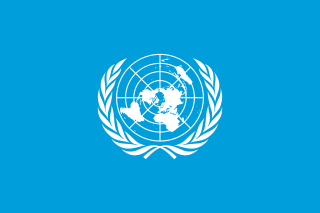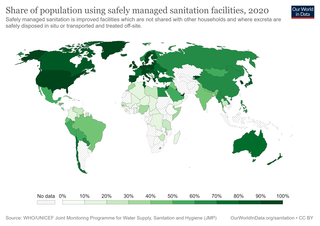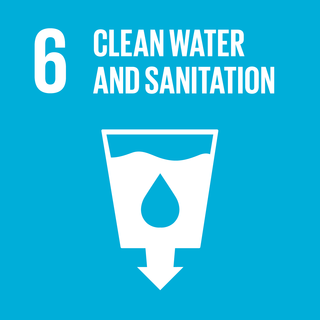Related Research Articles

Sanitation refers to public health conditions related to clean drinking water and treatment and disposal of human excreta and sewage. Preventing human contact with feces is part of sanitation, as is hand washing with soap. Sanitation systems aim to protect human health by providing a clean environment that will stop the transmission of disease, especially through the fecal–oral route. For example, diarrhea, a main cause of malnutrition and stunted growth in children, can be reduced through adequate sanitation. There are many other diseases which are easily transmitted in communities that have low levels of sanitation, such as ascariasis, cholera, hepatitis, polio, schistosomiasis, and trachoma, to name just a few.

Drinking water is water that is used in drink or food preparation; potable water is water that is safe to be used as drinking water.

Water purification is the process of removing undesirable chemicals, biological contaminants, suspended solids, and gases from water. The goal is to produce water that is fit for specific purposes. Most water is purified and disinfected for human consumption, but water purification may also be carried out for a variety of other purposes, including medical, pharmacological, chemical, and industrial applications. The history of water purification includes a wide variety of methods. The methods used include physical processes such as filtration, sedimentation, and distillation; biological processes such as slow sand filters or biologically active carbon; chemical processes such as flocculation and chlorination; and the use of electromagnetic radiation such as ultraviolet light.

The Millennium Development Goals (MDGs) were eight international development goals for the year 2015 that had been established following the Millennium Summit of the United Nations in 2000, following the adoption of the United Nations Millennium Declaration. These were based on the OECD DAC International Development Goals agreed by Development Ministers in the "Shaping the 21st Century Strategy". The Sustainable Development Goals (SDGs) succeeded the MDGs in 2016.

Solar Cookers International (SCI) is a 501(c)(3) nonprofit, non-governmental organization that works to improve human and environmental health by supporting the expansion of effective carbon-free solar cooking in world regions of greatest need. SCI leads through advocacy, research, and strengthening the capacity of the global solar cooking movement. SCI has consultative status with the United Nations Economic and Social Council (ECOSOC) and was founded in 1987.

An improved water source is a term used to categorize certain types or levels of water supply for monitoring purposes. It is defined as a type of water source that, by nature of its construction or through active intervention, is likely to be protected from outside contamination, in particular from contamination with fecal matter.

Improved sanitation is a term used to categorize types of sanitation for monitoring purposes. It refers to the management of human feces at the household level. The term was coined by the Joint Monitoring Program (JMP) for Water Supply and Sanitation of UNICEF and WHO in 2002 to help monitor the progress towards Goal Number 7 of the Millennium Development Goals (MDGs). The opposite of "improved sanitation" has been termed "unimproved sanitation" in the JMP definitions. The same terms are used to monitor progress towards Sustainable Development Goal 6 from 2015 onwards. Here, they are a component of the definition for "safely managed sanitation service".

With abundant water resources, Bangladesh faces various water contaminations mainly caused by pollutants, bacteria, and pesticides. Historically, water sources in Bangladesh came from surface water contaminated with bacteria. Drinking infected water resulted in infants and children suffering from acute gastrointestinal disease that led to a high mortality rate. According to UNICEF, 38.3% of Bangladeshis drink unsafe water from bacteria-contaminated sources. Bangladesh is facing an acute reliable drinking water scarcity. Bangladesh's surface and ground water are highly saline due to rising sea levels.

A sanitation worker is a person responsible for cleaning, maintaining, operating, or emptying the equipment or technology at any step of the sanitation chain. This is the definition used in the narrower sense within the WASH sector. More broadly speaking, sanitation workers may also be involved in cleaning streets, parks, public spaces, sewers, stormwater drains, and public toilets. Another definition is: "The moment an individual’s waste is outsourced to another, it becomes sanitation work." Some organizations use the term specifically for municipal solid waste collectors, whereas others exclude the workers involved in management of solid waste sector from its definition.
The Joint Monitoring Programme (JMP) for Water Supply and Sanitation by WHO and UNICEF is the official United Nations mechanism tasked with monitoring progress towards the Sustainable Development Goal Number 6 since 2016.
Health in Egypt refers to the overall health of the population of Egypt.
Water supply and sanitation in Japan is characterized by numerous achievements and some challenges. The country has achieved universal access to water supply and sanitation; has one of the lowest levels of water distribution losses in the world; regularly exceeds its own strict standards for the quality of drinking water and treated waste water; uses an effective national system of performance benchmarking for water and sanitation utilities; makes extensive use of both advanced and appropriate technologies such as the jōkasō on-site sanitation system; and has pioneered the payment for ecosystem services before the term was even coined internationally. Some of the challenges are a decreasing population, declining investment, fiscal constraints, ageing facilities, an ageing workforce, a fragmentation of service provision among thousands of municipal utilities, and the vulnerability of parts of the country to droughts that are expected to become more frequent due to climate change.
Deep Springs International (DSI) is a US nonprofit corporation, headquartered in Léogâne, Haiti, which supports the establishment and expansion of Gadyen Dlo social enterprises. Gadyen Dlo has been produced and distributed in Haiti since 2002, originally supported by Emory University and the US Centers for Disease Control.

WASH is an acronym that stands for "water, sanitation and hygiene". It is used widely by non-governmental organizations and aid agencies in developing countries. The purposes of providing access to WASH services include achieving public health gains, improving human dignity in the case of sanitation, implementing the human right to water and sanitation, reducing the burden of collecting drinking water for women, reducing risks of violence against women, improving education and health outcomes at schools and health facilities, and reducing water pollution. Access to WASH services is also an important component of water security. Universal, affordable and sustainable access to WASH is a key issue within international development and is the focus of the first two targets of Sustainable Development Goal 6. Targets 6.1 and 6.2 aim at equitable and accessible water and sanitation for all. In 2017, it was estimated that 2.3 billion people live without basic sanitation facilities and 844 million people live without access to safe and clean drinking water.

Solar water disinfection, in short SODIS, is a type of portable water purification that uses solar energy to make biologically-contaminated water safe to drink. Water contaminated with non-biological agents such as toxic chemicals or heavy metals require additional steps to make the water safe to drink.

Water issues in developing countries include scarcity of drinking water, poor infrastructure for water and sanitation access, water pollution, and low levels of water security. Over one billion people in developing countries have inadequate access to clean water. The main barriers to addressing water problems in developing nations include poverty, costs of infrastructure, and poor governance. The effects of climate change on the water cycle can make these problems worse.

A urine-diverting dry toilet (UDDT) is a type of dry toilet with urine diversion that can be used to provide safe, affordable sanitation in a variety of contexts worldwide. The separate collection of feces and urine without any flush water has many advantages, such as odor-free operation and pathogen reduction by drying. While dried feces and urine harvested from UDDTs can be and routinely are used in agriculture, many UDDT installations do not apply any sort of recovery scheme. The UDDT is an example of a technology that can be used to achieve a sustainable sanitation system. This dry excreta management system is an alternative to pit latrines and flush toilets, especially where water is scarce, a connection to a sewer system and centralized wastewater treatment plant is not feasible or desired, fertilizer and soil conditioner are needed for agriculture, or groundwater pollution should be minimized.
Environmental health policy is governmental action intended to prevent exposure to environmental hazards or "eliminate the effects of exposure to environmental hazards".

Sustainable Development Goal 6 is about "clean water and sanitation for all". It is one of 17 Sustainable Development Goals established by the United Nations General Assembly in 2015, the official wording is: "Ensure availability and sustainable management of water and sanitation for all." The goal has eight targets to be achieved by 2030. Progress toward the targets will be measured by using eleven indicators.
The Safe Water System (SWS) is a series of inexpensive technologies that can be applied as water quality interventions in developing countries. It was developed in conjunction by the US Centers for Disease Control and Prevention and the Pan American Health Organization. As of 2014, SWS had been implemented in thirty-five countries.
References
- ↑ "Safe household water storage". World Health Organization. Archived from the original on June 13, 2005. Retrieved 2 February 2010.
- ↑ "Solar Cooker Review". Solar Cookers International. November 2007. Retrieved 3 February 2010.
- ↑ "Resolution adopted by the General Assembly: 55/2. United Nations Millennium Declaration". United Nations. 6–8 September 2000. Retrieved 3 February 2010.
- ↑ : 48 "The Millennium Development Goals Report" (PDF). United Nations. 2009. Retrieved 3 February 2010.
- ↑ "Household Water Treatment and Safe Storage". World Health Organization. Archived from the original on October 25, 2004. Retrieved 3 February 2010.